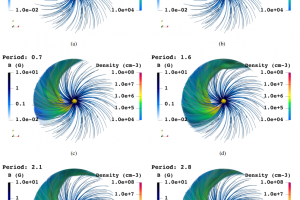Star-planet interactions: difficult, but not impossible. The study: “The enigmatic dance of the HD 189733A system: a quest for accretion” of S. Colombo (INAF-OAPA) appeared on A&A

Hot Jupiters represent an interesting class of exoplanets that does not exist in the Solar System. These are giant gaseous planets that orbit at such close distances from their stars that their orbital periods are shorter than 10 days. Due to their proximity to their stars, these planets have very hot atmospheres, with temperatures exceeding 1500 K. For this reason, they are often affected by photoevaporation, which is the loss of atmosphere due to the heating caused by the incident radiation.
Hot Jupiters are also of great interest for the study of star-planet interactions, typically arising from the interaction, often magnetic, between the star and the planet. These interactions are capable of producing observable effects on the stars. A notable example is the system of the star HD 189733A, a K1.5V star with a mass of 0.81 solar masses, hosting a planet with 1.13 Jupiter masses and an orbital period of just 2.22 days. In a series of papers published between 2010 and 2015, led by astronomers from our Observatory, evidence was presented supporting enhanced magnetic activity on the star, such as flares observable in X-rays, in phase with the planet orbit. Further analysis demonstrated that the flares could not have occurred in the corona of HD 189733A, but instead in the space between the star and its planet. However, these results were refuted in a paper published in 2015, which demonstrated that such activity could not have produced observable X-ray emission.
To conclusively determine whether the magnetic activity in HD 189733A could be induced by its planet, a team of researchers led by S. Colombo (INAF – Astronomical Observatory of Palermo) conducted MHD simulations of the system comprising HD 189733A and its planet. These simulations explored the magnetic interaction between the two objects. The models confirmed that the stellar wind incident on the planet can induce a class of instabilities known as Rayleigh-Taylor instabilities. These instabilities occur when gas at low density impacts gas at higher density and, in this case, are capable of causing significant mass loss from the planet. In this scenario, a large amount of matter (greater than a billion kg per second) is accreted onto the star. However, the simulations demonstrated that this is possible only for specific values of the planetary and stellar magnetic fields, specifically 5 G for the star and 1 G for the planet. Additionally, the accreting material should produce X-ray emission ten thousand times fainter than the average stellar X-ray brightness. Nevertheless, more intense X-ray emission can arise from the region where the two winds collide. The simulations are described in the paper titled “The enigmatic dance of the HD 189733A system: a quest for accretion” recently published in Astronomy & Astrophysics. The paper is also authored by astronomers I. Pillitteri, A. Petralia, S. Orlando, and G. Micela from INAF – Astronomical Observatory of Palermo.
The cover image (click here to view it in its entirety) depicts a time sequence of the density and configuration of the accreting flow over time, as predicted by the simulations. The figure also indicates the field lines, which allow for the visualization of the magnetic field topology. The flow is color-coded based on its density, as illustrated in the column on the right.
Mario Giuseppe Guarcello ( follow mariospiegacose) ( mariospiegacose) ( follow mariospiegacose)
Follow the Astronomical Observatory of Palermo on Facebok and on Instagram
Subscribe the Youtube channel of the Astronomical Observatory of Palermo
